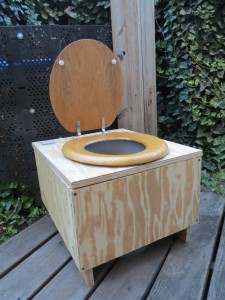If there was any book I’d recommend, even to someone that isn’t interested in environmental issues, it’s Humanure Handbook. I can confidently say this book is at the level of Silent Spring, and possibly higher ranking on my list than Rubbish.
How could a book about composting your bowel movements be important?
Urine, feces and food scraps are super high in nitrogen. Leaves, cardboard, paper, straw, hay etc are all high in carbon. When you mix these two components together, in time you get beautiful, fertile compost that our earth desperately needs.
What you don’t get is chlorine and sodium hypochlorite (amongst other things used in the water treatment process), and polluted air from burning off sewage sludge, or possibly worse having that sewage sludge spread on farmlands as a “soil amendment”, and then used to grow our food.
Jenkins goes into great detail about the history of feces around the world, from how 78,000 tons of humanure was bought for $31,000 gold in China, to how it has become a problem that seemingly no one wants to address.
Defecating in our water isn’t good. Even myself, spending most waking hours reading about environmental issues in one way or another, sees how this doesn’t register as a huge problem at first observation.
We flush the toilet and it goes away, just like our trash gets picked up at the curb and disappears. We forget about it, and that’s because very few of us ever confront it. That being said, please go visit a sewer treatment plant, a trash incinerator (which you will be deceptively urged to call “waste to energy”) or a landfill. All awesome eye openers.
We don’t notice what we breathe in, we don’t taste toxins. Jenkins can get pretty grim at times (especially in the beginning) but I can’t argue with him whatsoever…he simply tells it like it is.
His solution is pretty simple: A compost toilet paired with a compost pile and a rain barrel, (for cleaning). It goes without saying he’s an advocate of curbside compost collection as well. While I am too, composting at home is ideal since there’s no point in waiting around for your community to start curbside compost collection.
I went along with his easy-to-follow instructions for building a “lovable loo” and needless to say I am very impressed. It took me a couple hours to construct the toilet, and I love it. The sawdust created from constructing it was the first addition to the bucket, how perfect.
 [It lives in my basement next to the washing machine, not outside! I just wanted to get a good picture.]
[It lives in my basement next to the washing machine, not outside! I just wanted to get a good picture.]
I fill one 5 gallon bucket a week, and I have to make a trip to a local woodshop every few months to pick up my sawdust supply, which is a mutual benefit for sure.
I have a 3′ x 3′ x 3′ compost pile in the yard that is always cooking at a sustained higher temperature than I ever got without the humanure additions. No matter how much material I dump in per week, the pile seems to stay the same size!
This is the magic of humanure composting. Jenkins states to fill one compost bin for a year, then switch to a brand new pile for a year. Once the second pile fills up after a year, empty the first one, which will be nothing but beautiful compost.
It’s not all perfect, though. I’d say the trickiest part of the process, which I don’t recall being mentioned at great length in the book (time to read it a third time), is the dust issue.
Using fine sawdust can be a bit…dusty, of course. I found that adding a spray bottle into the mix worked decently, but it is a bit too laborious. I want to spend my time on the can reading a book, not spraying down sawdust. Therefore, I just sprinkle the whole bucket’s worth of sawdust with some rainwater from my watering can. Much, much better.
The way Jenkins does it, which I can’t really abide by due to space constraints, is to have a huge pile of sawdust outside next to the compost pile. If it got naturally rained on from time to time, it would be much cleaner to work with since it would absorb plenty of moisture.
However, I’m a bit paranoid with having such a large flammable source exposed in the yard, which is yet another benefit to putting a tarp on the compost pile. I’ve had people throw cigarette butts over the fence into the yard… so yeah. One of those times I wish I lived in the sticks, like Jenkins.
All in all, the process takes about 10 minutes a week to complete, and I find it to be time well spent. Every time I empty my toilet, I find myself thinking about what the hell I’m doing, but in a good way. It puts pressure on me to consume less and less plastic materials, because other than that, most everything is recyclable or compostable.
If you’re really into the survival/prepper mentality, this skill is a no-brainer. If we had an extended grid-down situation or lost access to water, a compost toilet would be critically important and I’m proud to have one.
The book ends with a great interview of Jenkins…by Jenkins. It really takes all the typical questions asked and makes it look like naive, old thinking. I won’t ruin it, you’ll have to pick up the book to enjoy it for yourself.
I’ll say it again- if you’re into environmental issues and want to learn about one of the most critical topics not being discussed, the Humanure Handbook will make you question your lifestyle at length while being an enjoyable read at the same time.


I would like to send a proposal to our local municipality about using waste from the sewer to humanre and assist in seting up a big faiclity to do this.if you have any organisation that do this please send me their contacts.
is your municipality currently composting sewer sludge? i would try to find out what they’re doing with it and see what answers you get.